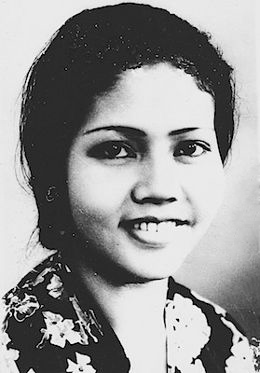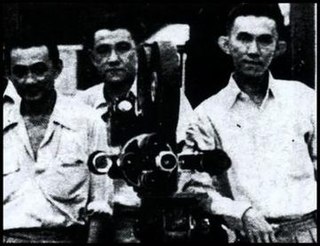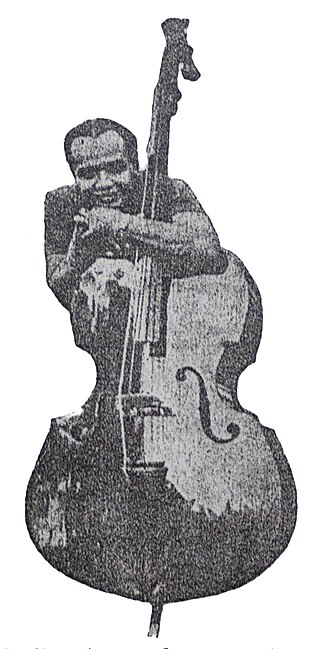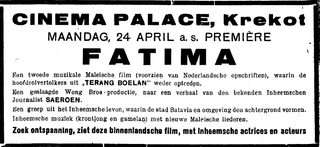Related Research Articles

The cinema of Indonesia refers to films produced domestically in Indonesia. The Indonesian Film Board defines Indonesian films as "movies that are made by or using Indonesian resources whose Intellectual Property Right is owned either entirely or partly by Indonesian citizen or Indonesian legal entity".

Zuster Theresia is a 1932 film from the Dutch East Indies directed by M. H. Schilling with the help of the Wong brothers. The film, starring Henk Maschhaup, Daisy Diephuis, and Alle Heymann, follows a young man and his relationship with two women. A commercial failure, the film was the last made by Schilling and led the Wongs to take a two-year hiatus.

Tan's Film was a film production house in the Dutch East Indies. Established by the brothers Tan Khoen Yauw and Tan Khoen Hian on September 1, 1929, its films were mostly targeted at native ethnic groups. Starting with Njai Dasima in 1929, the company released fifteen movies before ultimately being dissolved after the Japanese occupation. The Tans and the Wong brothers established Tan & Wong Bros in 1948 to continue this work.

Pareh, released internationally as Pareh, Song of the Rice, is a 1936 film from the Dutch East Indies. Directed by the Dutchmen Albert Balink and Mannus Franken, it featured an amateur native cast and starred Raden Mochtar and Soekarsih. The story follows the forbidden love between a fisherman and a farmer's daughter.

Mannus Franken was a Dutch filmmaker who played an important role in the development of Indonesian cinema. He made his debut as a writer before working with Joris Ivens in producing two documentary films. In 1934 he was called to the Dutch East Indies by Albert Balink to help with the production of Pareh (1936). Franken stayed in the Indies until before World War II, making newsreels. After the war he returned to the country and continued this work. In 1949 Franken returned to the Netherlands, where he made another film before his death.

Albert Balink was a Dutch journalist and filmmaker who contributed to early Indonesian cinema. Born in the Netherlands, he began a career in film journalism in the Dutch East Indies. A self-taught filmmaker, in the mid-1930s, he released a documentary and two feature films, before immigrating to the United States and resuming his journalistic career.

The Teng Chun, also known by his Indonesian name Tahjar Ederis, was an Indonesian film producer. Born to a rich businessman, The became interested in film while still a youth. After a period as an exporter, in 1930 he established Cino Motion Picture to produce films in the Dutch East Indies. In a little over a decade he and his company had released at least 31 films, including some of the country's first talkies. Although he experienced a brief resurgence during the 1950s, after Indonesia became independent, he spent the last years of his life as an English teacher.

Hajji Raden Mochtar, often credited as Rd Mochtar, was an Indonesian actor. Of noble descent, Mochtar was discovered by Albert Balink and first cast in the commercial failure Pareh (1936). Rising to popularity after the release of Terang Boelan the following year, he spent nearly sixty years in film, while also becoming a businessman and farmer.

Terang Boelan is a 1937 film from the Dutch East Indies. Written by Saeroen, directed by Albert Balink, and starring Rd Mochtar, Roekiah and Eddie T. Effendi, Terang Boelan follows two lovers who elope after one is almost forced to marry an opium smuggler. The film was shot in the Indies and Singapore, and was partially inspired by the 1936 Hollywood film The Jungle Princess. It was aimed at native audiences and included keroncong music, which was popular at the time, and several actors from Balink's previous work Pareh (1936).

Roekiah, often credited as Miss Roekiah, was an Indonesian kroncong singer and film actress. The daughter of two stage performers, she began her career at the age of seven; by 1932 she had become well known in Batavia, Dutch East Indies, as a singer and stage actress. Around this time she met Kartolo, whom she married in 1934. The two acted in the 1937 hit film Terang Boelan, in which Roekiah and Rd Mochtar played young lovers.

The Wong brothers were three ethnic Chinese film directors and cameramen active in the cinema of the Dutch East Indies. The sons of an Adventist preacher, the brothers – Nelson (1895–1945), Joshua (1906–1981), and Othniel (1908–1986) – received much of their education in the United States before going to Shanghai and establishing The Great Wall Productions.

Raden Mas Kartolo was an Indonesian actor and songwriter. Born in Yogyakarta to a noble family, he entered the theatre and married the actress Roekiah around 1933. The two, living in Batavia acted in numerous movies together, starting with the 1938 hit Terang Boelan. However, Roekiah was always cast with other actors as her romantic interest. After Roekiah died in 1945, Kartolo brought the family to Yogyakarta and worked with Radio Republik Indonesia until his death. One of his sons, Rachmat Kartolo, went on to be an actor in the 1960s and 1970s.

Fatima is a 1938 film from the Dutch East Indies directed by Othniel and Joshua Wong. Written by Saeroen, it starred Roekiah, Rd Mochtar, and ET Effendi and followed two lovers who are disturbed by a rich youth. The film followed the same formula as the earlier hit Terang Boelan, and saw commercial success domestically. It is one of three films which Misbach Yusa Biran credits with reviving the domestic film industry, which had been faltering.

Gagak Item is a 1939 bandit film from the Dutch East Indies directed by Joshua and Othniel Wong for Tan's Film. Starring Rd Mochtar, Roekiah, and Eddy T. Effendi, it follows a masked man known only as "Gagak Item". The black-and-white film, which featured the cast and crew from the 1937 hit Terang Boelan, was a commercial success and received positive reviews upon release. It is likely lost.

Zoebaida is a 1940 film from the Dutch East Indies directed by Njoo Cheong Seng. A romance set in Timor, it starred Njoo's wife Fifi Young and was the film debut of Soerip. Shot over a period of 27 days in a Dutch-owned studio, the film received middling reviews. It is likely lost.

Ouw Peh Tjoa, also known by the Malay-language title Doea Siloeman Oeler Poeti en Item, is a 1934 film from the Dutch East Indies. It was directed and produced by The Teng Chun. Adapted from Legend of the White Snake, a Chinese folktale, it follows a magical snake who passes as a human but ultimately dies. The film, now possibly lost, was followed by one sequel, Anaknja Siloeman Oeler Poeti, in 1936.
Gadis jang Terdjoeal is a c. 1937 film from the Dutch East Indies. It was directed by The Teng Chun, his first film to recognise native interests.

Oriental Film was a film production company in Batavia, Dutch East Indies. Established by ethnic Chinese businessman Tjo Seng Han in 1940, it completed four black-and-white films before it was closed in 1941. All the company's films were screened into the 1950s but may now be lost. They were directed by two men, Njoo Cheong Seng and Sutan Usman Karim, and launched the careers of actors such as Dhalia and Soerip.
References
- ↑ Biran 2009, pp. 380–381.
- ↑ Biran 2009, p. 145.
- ↑ "Java Pacific Film bij Film in Nederland". EYE Film Institute Netherlands . Retrieved 24 July 2012.[ permanent dead link ]
- 1 2 Biran 2009, p. 156.
- ↑ Biran 2009, p. 165.
- ↑ Roberts, Martin (2000). "Indonesia: The Movie". In Hjort Mette (ed.). Cinema and Nation. Scott MacKenzie. Psychology Press. pp. 162–76. ISBN 9780415208635 . Retrieved 23 July 2012.
- ↑ Biran 2009, p. 159.
- ↑ Biran 2009, p. 162.
- ↑ Biran 2009, pp. 161–62.
- ↑ Gray, Gordon (2010). Cinema: A Visual Anthropology. Oxford: Berg. ISBN 978-1-84520-793-9.
- ↑ "Pareh, een rijstlied van Java". filmmuseum.nl. Amsterdam: EYE Film Institute Netherlands. 20 October 2011. Archived from the original on 23 January 2018. Retrieved 23 July 2012.
- ↑ Prayogo, Wisnu Agung (2009). "Sekilas Perkembangan Perfilman di Indonesia" [An Overview of the Development of Film in Indonesia]. Kebijakan Pemerintahan Orde Baru Terhadap Perfilman Indonesia Tahun 1966–1980[New Order Policy Towards Indonesian Films (1966–1980)] (Bachelour's of History Thesis) (in Indonesian). University of Indonesia.
- 1 2 Biran 2009, pp. 165–166.
- ↑ Sen, Krishna; Hill, David T. (2006). Media, Culture and Politics in Indonesia. Equinox. p. 138. ISBN 9789793780429 . Retrieved 24 July 2012.
- ↑ Biran 2009, pp. 167–168.
- ↑ Slobin, Mark (2008). Global Soundtracks: Worlds of Film Music. Wesleyan UP. p. 217. ISBN 9780819568823 . Retrieved 24 July 2012.
- ↑ "Algemeen Nederlandsch Indisch Filmsyndicaat (ANIF)". Jakarta City Government (in Indonesian). Jakarta City Government. Archived from the original on 24 June 2012. Retrieved 25 July 2012.